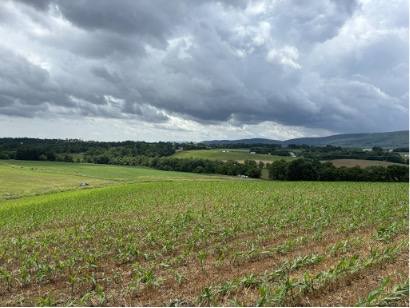SOARE: SWAG Summer Research Experience
Written by: Eric Martineau
The annual problem of my generation is finding a good way to spend their summer vacation, but luckily for me, I didn’t have any questions about what I wanted to do. I was offered a scholarship position in the Summer Opportunities in Agricultural Research and the Environment: Strategic Work in Applied Geosciences (SOARE: SWAG) program at the University of Maryland (UMD) College Park. This is a very prestigious program funded by the National Science Foundation (NSF) that asks its scholars to perform a nine-week research project and then create a poster that will be presented to other scholars as well as experts in the field.

One of my favorite memories from the experience was the day I went out to the field with Mr. Casey Greuffe, one of the faculty assistants for Dr. Toor. We drove up from College Park, Maryland, to a small farm outside of Middletown on the border of West Virginia and Maryland in the heart of the Appalachian Valley. This quaint town is nestled right in the center of the beautiful Blue Ridge vistas and is only a little more than an hour’s drive away from Washington, D.C. It was a perfect June day, with the summer sun shining brightly and a light breeze rustling the leaves of the cornfields, making the experience even more memorable. Our goal that day was to collect soil core samples from the farm to test for the levels of nitrogen, specifically nitrate and nitrite, over the months (May to September) of corn growth until harvest. These measurements would help us understand how nitrogen moves through the soil and was taken up by the corn plants during their development.
This summer, I worked in a nutrient management lab focused on soil and water quality on Maryland farms. The lab team, led by Dr. Gurpal Toor, studied how elements like nitrogen and phosphorus when over applied to farmland, move through the soil and impact surrounding ecosystems. Our research aimed to understand how nutrient runoff can lead to environmental issues, such as eutrophication, as well as dangers to human communities, such as infant methemoglobinemia. I gained hands-on experience in collecting soil and water samples, preparing them for analysis, and using advanced lab equipment to measure nutrient concentrations. Some of the methods I used were colorimetric analysis as well as carbon combustion and then infrared spectroscopy. As a part of my internship, I created a poster presentation on “Modern Research Methods in Soil and Water Quality Investigations”, emphasizing the impact of excess nutrients on community stakeholders and local wildlife. The project helped me develop skills in technical writing, data interpretation, and public speaking. Working on the poster under Dr. Toor’s guidance allowed me to effectively present our findings and discuss the broader implications of nutrient management for sustainable agriculture and environmental protection.
To avoid boring my audience with the minutiae of how we randomly selected which rectangle of soil to sample, I’ll just briefly explain the sampling steps. After randomly selecting a 2-by-3-foot plot of soil, we would first estimate the life cycle stage of the corn growing there, which involved inspecting the plant’s height and leaf development. At the time, each plot’s corn was only about four weeks old and stood around twelve inches tall, just having established its roots and leaves no more than two weeks prior. After making these observations, we would proceed to carefully harvest all of the young corn plants and any other surface organic matter, such as weeds or decomposing cover crops from the spring. These samples would be taken back to the lab, where we could grind and then analyze them to measure their nitrogen content, providing us with valuable data on the nitrogen uptake of the plants.

Next came the most physically demanding part: using a manual soil corer, which is essentially a long, cylindrical tube, to extract samples from below the surface. This task required a lot of physical effort, as the corer had to be driven deep into the soil to get samples from different depths. To make matters worse, we were sampling in a mountainous region where the soil is thinner and karstic, so it was difficult to get a good sample that was not full of limestone rocks. Since we were dividing the cores into. The process was labor-intensive, often involving pulling the soil core out of compacted soil and repeating the process six, often more, times across three different plots. However, despite the physical challenge, it was incredibly rewarding to know that each sample we collected would contribute to our understanding of sustainable agricultural practices. This was just one site of many spread out across Maryland to get a better understanding of how topography and soil order impact crop health and nitrogen leaching. This field visit was a hands-on experience that not only taught me about soil sampling techniques but also deepened my appreciation for the hard work involved in field research.
I would like to extend my gratitude to Dean Evelyn Cooper, PhD, and Dr. Candice Duncan for their hard work in planning and leading the SOARE: SWAG program. Additionally, I am grateful for the supportive and welcoming community in the lab where I worked. I especially want to thank Dr. Gurpal Toor, Dr. Patricia Steinhilber, and Ms. Kelly Hayden, whose mentorship made my first research experience truly rewarding. Their guidance and encouragement have significantly contributed to my professional and personal growth, providing me with invaluable insights into graduate research. I look forward to applying the skills and knowledge I have gained throughout this internship one day while doing research into soil ecology. I am now beginning the process of reaching out to potential graduate mentors and Masters programs around the world, hopeful to continue my education in ecology and evolutionary biology.